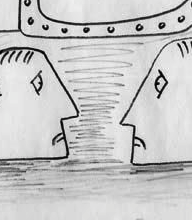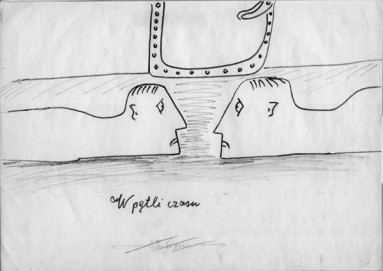In his prophetic nonfiction, Stanis?aw Lem described a technologized world where humans do not plagiarize from nature but invent creatively and freely
In his memoir of childhood, Stanis?aw Lem describes the activity that absorbed his attention around the age of twelve. The Polish science fiction writer and polymath invented an elaborate bureaucracy worthy of a pubescent Kafka, complete with passwords and paperwork, requisitions and requests, and above all, documents of authorization. In the center of the bureaucracy’s imaginary hierarchy, “a shape began to emerge from nothingness, a Building, a Castle unbelievably High, with a Center of Mystery never named, not even by the most daring — the place where, after passing through all the gates, halls, and guard stations, you could finally receive full authorization!” The young Lem never tried to produce the blank form granting full authorization hidden in the files of the High Castle, but its inscrutable and ultimately inaccessible power would find many analogs in his mature fiction, from the mysterious, living sea in Solaris to the uninterpretable message from space in His Master’s Voice. But these vacant symbols, which at first seem capable of authorizing anything, invariably end up as the screens upon which characters project the content of their own minds. So it is with the void to which Lem returned again and again, the emptiest and most promising of all — the future.
“Only prophecy,” Lem suggests in his volume of mock reviews, A Perfect Vacuum, can provide “new terrains for creativity, those in which can be found a resistance that will lend an element of menace and risk — and therewith importance and responsibility — to the situation.” In his 1964 nonfiction volume of techno-philosophy, futurology, and cybernetic theory Summa Technologiae, newly translated into English for the first time by Joanna Zylinska, he had already tried his hand at the practice. Summa Technologiae, in Lem’s view his most important work, takes its title from Thomas Aquinas’ Summa Theologica. Like its namesake, it attempts to provide a foundation for thought that encompasses, but is not limited to, human experience. There the resemblance ends. While Aquinas tried to ground his philosophy in the eternal, Lem’s vision is relentlessly, often restlessly dynamic, moving from the possibility of alien life to virtual reality (“phantomatics”) to the intelligence of robots, all considered in terms of their future development.
For all its range, however, Summa Technologiae takes its impetus from a single analogy: the comparison of biological and technological evolution. Drawing heavily on Norbert Wiener’s research in cybernetics, Lem describes both the biosphere and technology as feedback systems that develop in response to changes in their environment, each tending toward an “ultrastable equilibrium”. These core similarities allow Lem to draw ingenious and often bizarre connections between the two processes. In chapter 7, “The Creation of Worlds,” he describes “information farming,” a method of arriving at new discoveries by using a controlled process of biological evolution in which the genetic information of microorganisms models theories. “Information should develop from information, just as organisms develop from organisms,” he remarks. Yet he is also sensitive to the discontinuities between the technological and biological evolution, and the potential of each to interfere with the other. Returning to his original comparison after five chapters describing possible trajectories of technical change, he concludes by imagining the collision of the two kinds of evolution: “The invasion of technology created by man into his body,” he declares, “is inevitable”. The development of all life, including humans’, will likely be caught up and carried along by the forward momentum of science.
The emerging fields of cybernetics and information theory allowed Lem to draw analogies between vital and mechanical processes, as scientists across disciplines were beginning to do in the fifties and sixties. And as Lem well knew, in describing evolution — technical and biological — in terms of the transfer of information, as a series of messages carried imperfectly across time and space, information theory had the potential to affect the interpretation of language, imperceptibly reimagining the terms of its own metaphor. The text of Summa Technologiae itself was nearly as fluid, and as sensitive to its historical environment, as any of the homeostatic systems Lem describes. The first edition was issued in 1964, with three subsequent editions, each encompassing corrections and revisions. The second appeared in the same year, the third in 1967 and the fourth in 1974, the last of which Zylinska refers to as “arguably the most mature and up-to-date edition,” and which serves as the basis of her translation. The history of its transformations across editions will necessarily remain hidden from its English readers; the volume’s notes, which are minimal, do not and are not intended to illuminate the process. But even through the lens of translation, we can sense the daring its first publication must have had in the Poland of 1964.
Imagining the future is always a political act. Though the future Lem considers is only tangentially concerned with politics, there are polemical undertones to his sense of its radical contingency and its tendency to escape the control of would-be architects. “In trying to contain self-induced oscillations of a system by force,” he remarks, “one is abandoning the principle of homeostasis, since the system’s self-organization is replaced with violence. This is how historical forms of power, such as tyranny, absolutism, fascism, and so on, came about”. Lem, born to parents with Jewish ancestry in Poland in 1921, had firsthand experience of the ways in which historical actors might attempt to shape a system by means of violence. He survived the Nazi occupation of Poland with the help of forged identity papers, documents that surely haunt his later memories of his childhood experiments in bureaucratic invention. His relation to the Communist state that followed was troubled, in part because of the very ideas that form the core of Summa Technologiae: the scientific newsletter for which he wrote in the late forties was penalized for his critique of Lysenkoism, the officially-sanctioned account of evolution that briefly replaced Darwinian theory, while his interest in cybernetics preceded political acceptance of the field. At the same time, his sense of the transformative implications of technology for social structure is indebted to Marxist theory, “But what causes the transformation of social systems?” he asks, in order to reply, “We know that a change to the means of production, that is, to technologies, is its driving force”.
The witness and victim of a kaleidoscope of political regimes, Lem saw himself as an observer standing on the periphery of history, like his recurring character Ijon Tichy, an intergalactic traveller who flits from civilization to civilization across space and even, occasionally, time. In the satirical novel The Futurological Congress (1971), Tichy, participating in an academic conference on the discipline of futurology, finds himself transported into the year 2098, an unwilling spectator at the scene of his own predictions. In the decades after the first edition of Summa Technologiae was published, Lem shared his character’s fate. But in contrast to most would-be prophets, Lem, who had an uncanny sense of the drift of history, found the experience gratifying, as one prediction after another was fulfilled. In a 1991 reply to a critical review the philosopher Leszek Ko?akowski had written at Summa Technologiae’s first publication, Lem focuses on his chapter on “phantomatics” or virtual reality — the latter term did not come into use until more than two decades after he wrote — to boast of his prescience not only in imagining the possibility of computer-simulated reality, but also in anticipating some of its uses, as for example in instructional contexts. “Is this not enough,” he asks, “to speak of predictive accuracy?” Lem lost no opportunity to point out his successes.
Yet prophecies have a curious feature: they lose much of their interest by proving right. So long as their predictions are deferred, they remain the best guide to the future they promise. But when the event they imagined occurs, they are simultaneously validated and made obsolete. Why read Summa Technologiae in 2013, when technology has deviated from Lem’s vision in some respects and — even worse — fulfilled it in others? For one thing, many of its predictions span milennia, and may, perhaps, become more relevant with time; we do not yet live in an age in which teleportation, a technology whose moral problems Lem discusses at some length, is possible. But in my view the source of Summa Technologiae’s most enduring interest lies elsewhere — not in his accuracy as a futurologist, but rather in the unusual perspective he brings to technological ideas as a writer of fiction.
Lem resisted critics’ attempts to see his philosophical writing as vitally linked to his novels and stories, maintaining that on the contrary it represented a turn away from the freedoms of imaginative literature toward a harder and clearer view of reality. “We shall be drawing on… the method followed by the scientist, which,” he insists, “has very little in common with the artist’s method”. Despite his protests, Lem’s experience as an artist is visible throughout the book, as is the influence of earlier writers of science fiction, particularly Olaf Stapledon, whose Last and First Men describes an arc of human development two billion years long. Far from a liability, many of Lem’s best insights are a product of this orientation. Emphasizing the construction rather than the interpretation of reality — Summa Technologiae rather than Summa Scientiae — he imagines a technologized world in which humans do not “plagiarize” from nature but invent creatively and freely, like writers of fantastic literature free from by the conventions of mimesis.
The historian and philosopher of science Peter Dear has suggested that Western science can be understood as “a kind of dialectical interaction between natural philosophy and instrumentality,” that is, between pure science and technology. Theory and practice, in this account, are mutually intertwined and mutually reinforcing. By way of contrast Lem, assisted by cybernetics, envisions a future in which the construction of new technologies no longer reinforces but rather exceeds the project of comprehending nature. In a chapter entitled “Prolegomena to Omnipotence,” he writes,
It is only when we are eventually able to compete with Nature on the level of creation, when we have learned to copy it so that we can discover all of its limitations as a Designer, that we shall enter the realm of freedom, of being able to work out a creative strategy subordinated to our goals.
Given that it is now possible to buy a synthetic biology kit containing all the materials necessary for assembling new genetic systems for a few hundred dollars online, this vision looks more relevant every day.
In his concluding chapter, “A Lampoon of Evolution,” Lem argues that eventually technology will not only diverge from nature, but also improve upon it. Biological evolution is blind, chaotic, and frequently wasteful. Human designers who begin with a sense of teleology in mind may be able to achieve more elegant solutions — even, perhaps, to the problems of their own construction. It with respect to this final subject that Lem sees prediction as most fallible and yet most necessary, perhaps because, as he suggests earlier in the volume, “It is easier to plan development in advance than to transform the dynamics of a fully formed system in any significant way”. If prognostication is intended to shape behavior as well as predict it, futurology itself is as much a form of invention as a method of description — an art or a technology rather than a science. Where Summa Technologiae succeeds, then, it is precisely because of Lem’s creativity, his ease with invention as both a literary and technological concept. The future may always be a projection of the present, but unlike the flat projections of cinema, its figures occasionally step off the screen.


